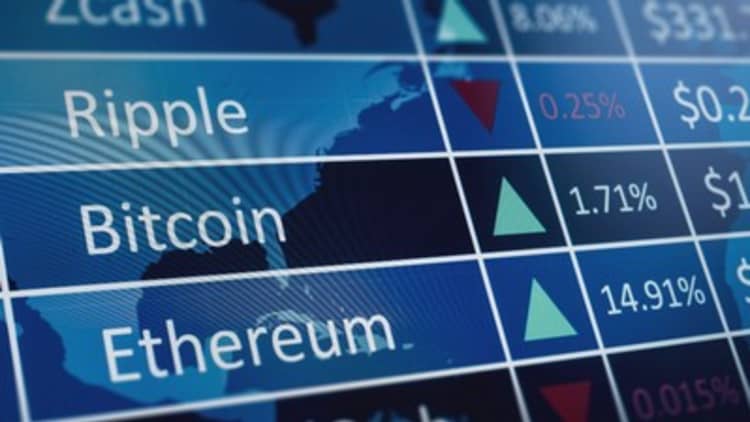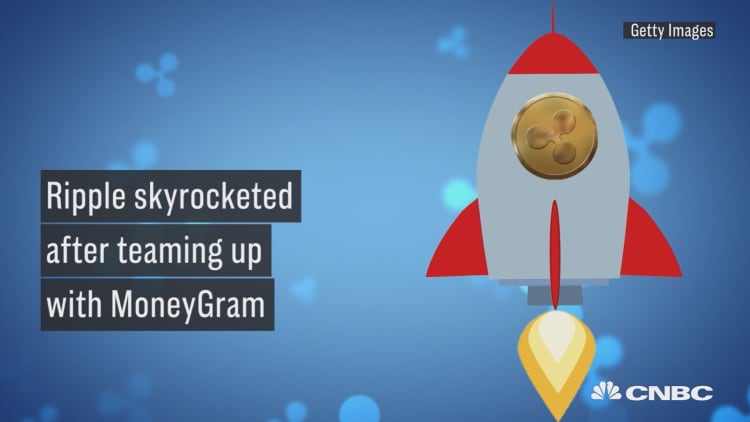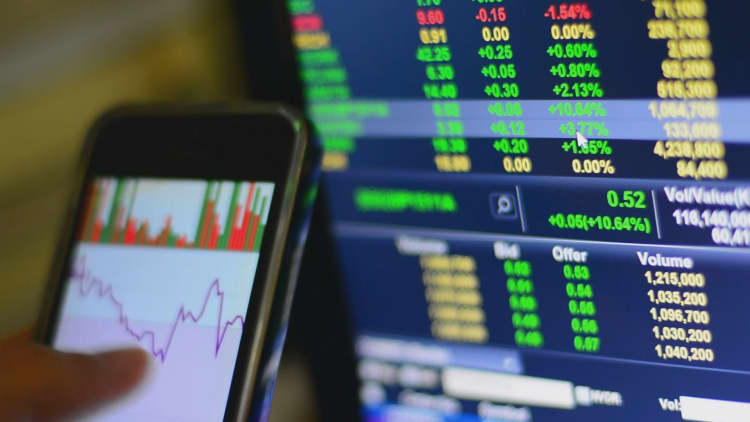Sixteen months ago, Ripple raised $55 million by selling equity in a typical Silicon Valley funding round from strategic investors, following earlier financing from Alphabet's GV (Google Ventures), Andreessen Horowitz and others. The round placed the value of the company around $400 million.
Today the San Francisco start-up could bring in many times that amount of cash every month -- if it wanted to -- without giving up any company ownership or control.
Ripple develops software that banks use for fast global financial settlements. But almost all of its current value comes from being the creator and majority holder of XRP, a digital currency that was obscure a year ago, but now has a total market value of about $130 billion.
XRP, which trades publicly like bitcoin, went on an inexplicable rally starting last year. Even after plummeting from a high of $3.84 in early January to $1.30 (including a 30 percent drop on Tuesday), it's still up almost 200-fold in the past 12 months.
Ripple owns about 60 billion of the 100 billion XRP created, giving it a market value -- based just on its holdings -- of close to $80 billion.
The company's revenue is unknown, although CEO Brad Garlinghouse told CNBC that some banks are paying the company millions of dollars for its software. Regardless, $80 billion is far ahead of where any reasonable investor would value the company.
A tough company to value
Ripple has placed limitations on how much XRP it can sell each month to remove the concern that it will suddenly flood the market with tokens. The company placed 55 billion of its XRP in a "cryptographically-secured" escrow account and can release up to 1 billion every month. Ripple has never come close to selling that amount in a month and said in December that it's averaged selling 300 million XRP a month since mid-2016.
By selling a tiny fraction of its holdings each month, the company brought in over $90 million in the first three quarters of 2017.

Ripple hasn't released its fourth-quarter XRP report yet, but if it continued selling the same amount programmatically, as a percentage of overall XRP traded, it would have raised more than $75 million in the fourth quarter and another $150 million just in the first half of January. That doesn't include money made from direct sales.
The company can dial back how much XRP it puts on the market, so there's no reason to expect that it's reeling in hundreds of millions of dollars a quarter. But just having that ability puts Ripple in a cash position that's extremely rare -- particularly for a start-up with just 170 employees -- and gives it the flexibility to quickly bring in money for a pricey acquisition, fund an ambitious new project or invest in other start-ups.
Ripple executives just invested some of their XRP as part of a $25 million funding round in a storage start-up called Omni.
"In all likelihood, they need cash less than any other company on the planet," said Timothy Enneking, managing director of Crypto Asset Management, a crypto hedge fund in San Diego with about $70 million in assets.
Jeremy Liew of Lightspeed Venture Partners invested in Ripple in 2013, before the currency had any value and when the company was focused on consumer peer-to-peer payments. He doesn't have a board seat and isn't close to the company, but is suddenly looking at a potentially very valuable stake.
Figuring out exactly how to value that stake is no easy task: Lightspeed owns illiquid shares in a private company, whose soaring paper value is derived from a highly volatile asset that it plans to monetize in small chunks over the course of many years.
"It's absolutely unprecedented," said Liew, who's best known for his early bet on Snap. "It hadn't been material until the end of last quarter, so now we have to think it through."
Seagate, through an investment in Ripple in 2016, could own a stake worth close to $8 billion, according to a report last week from Deep Value Research. The stock has rallied 20 percent since the report on Jan. 8, even though the company has said nothing about it publicly.
The anti-bitcoin
While Ripple's ability to practically print money puts it in an admirable place, the start-up has attracted plenty of controversy in the world of cryptocurrencies and blockchain.
Bitcoin is a decentralized currency that has to be mined to enter circulation and was created by a mysterious and still unidentified person using the pseudonym Satoshi Nakamoto.
The Ripple payment system, by contrast, is the creation of a single company that owns the majority of XRP and has control over when it hits the market.
Critics on Reddit and elsewhere comment on how crazy it is that Ripple just created a currency "out of thin air." Additionally, the currency is hardly being used, making it even more difficult to justify the price surge.

Ripple's core product, xCurrent, is used by banks as a messaging solution that allows them to settle cross-border payments quickly. But they're not using XRP for that. A newer and still nascent Ripple product called xRapid allows financial institutions to convert fiat currencies to XRP quickly and cheaply, and transact digitally in real time.
Last week Ripple made its first significant customer announcement for xRapid. It said that MoneyGram will use the technology and XRP to speed up and reduce the cost of transferring money. Viamericas, a money transmitter focused on sending money to Latin America and Asia, said that that it's testing XRP.
Ripple claims an average transaction on its network takes between two and three seconds to process. Bitcoin transactions take around 51 minutes on average, according to data by industry website Blockchain.info.
"Bitcoin showed us what's possible, but it's not going to solve every use case," said Garlinghouse, Ripple's CEO, who personally owns billions of dollars worth of combined Ripple equity and XRP at the current price. "I'm personally long bitcoin, because I think it solves a problem around the store of value."
In other words, Garlinghouse sees bitcoin as a form of digital gold, attracting investors looking to diversify their holdings. But XRP has a specific use and, if he's right, it will be the way that financial firms transact over blockchain.
"We're driving velocity and demand of XRP," Garlinghouse said.
None of that makes it any easier to grasp the value of XRP, which helps explain the wild price swings. The best explanation for its surge is the increasing global interest in cryptocurrencies and the proliferation of online exchanges that make it possible to buy, sell and hold these types of assets.
Enneking said that for his Crypto Asset Management fund he recently shorted XRP, and he's been more bullish on bitcoin and ethereum.
"I have a tough time understanding, even if a lot of banks use Ripple to move billions of dollars, why does that increase the value of XRP?" he said. "I don't understand what drives price formation."
If 2017 (and 2018 so far) has taught us anything about cryptocurrency, it's that extreme volatility is the norm. XRP could crash below 10 cents just as quickly as it soared past $3 for any number of reasons, or no reason at all.
With that sort of risk, it would make sense for Ripple to maximize its monthly XRP sales and pad its cash position as much as possible. But Garlinghouse gave no indication that he's pushing in that direction.
"For everything I do, I think what is in the best interest of the XRP ecosystem," he said.
Correction: A previous version of this story mistakenly said GV and Andreessen Horowitz participated in the 2016 round, instead of noting that they were earlier investors. It also incorrectly said Ripple created XRP currency, but it actually started the payment system.
WATCH: How to buy ripple, one of bitcoin's hottest competitors



